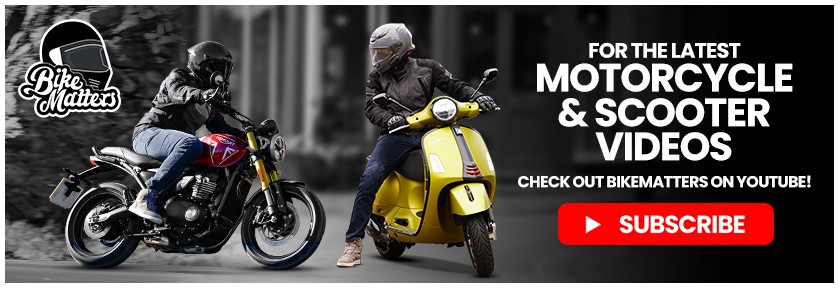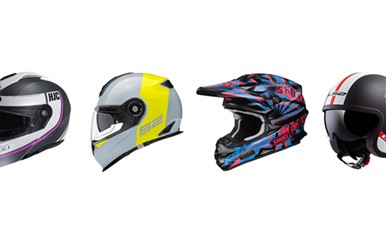Beginning motorcycling can be one of the best and most exciting and rewarding things you can do – but also one of the most daunting and, let’s face it, dangerous.
Nor does getting your CBT certificate or passing your test (meaning you’re now legally riding on the road) entitle you to feel fully equipped for your new biking life.
But it doesn’t have to be that way.
As long as you accept that you’re at the very start of your biking journey, understand that you’ve lots to still learn, get the right equipment, clothing and advice, and adopt the right motorcycling mindset, there is no reason why you can’t have a fulfilling, safe and thoroughly enjoyable biking life. So, what should you be looking to do, exactly?
Here are our Top 10 tips for surviving your first months in motorcycling…
1. Get the right kit

Arai TT Helmet
Before even you’ve bought your first bike, and certainly before you venture out onto the road, you MUST prioritize getting the right kit both to satisfy legal requirements but also to keep yourself safe and comfortable.
Legally, you MUST wear a safety helmet that meets either British Standard BS 6658:1985 and carry the BSI Kitemark or, more likely, meet the CE Regulation 22.05. You can buy one that meets that for as little as £50, but we’d strongly advise getting the best you can afford. In terms of safety, the Safety Helmet Assessment and Rating Programme (SHARP) shows you approved helmets and how much protection they offer. It's also vital that whichever helmet you choose fits correctly and is comfortable, which is why we also recommend visiting a respected store, taking advice, and trying different ones before you buy.
And that’s just the start. You also need a protective jacket, trousers, boots and gloves. All also come with CE ratings and cover a massive spectrum so do your research carefully, keep in mind the likely use and weather conditions you’ll be riding in, budget accordingly, and, again, try before you buy. Extra kit items such as thermals, rainproof oversuits, neck warmers and possibly riding rucksacks should also be considered within your budget.
2. Get the right bike | For you

CF Moto Stand at the Motorcycle Live Show 2024
Only now can you budget for your first proper road bike (after all, you can have some bike kit and not a bike, but you can’t ride a bike without the right kit).
Obviously, personal preference plays a part but when you’re starting out licence restrictions (A1, A2 etc), your budget and, yes, ‘you’ are even more important. In other words, with the first three ‘filters’ being fixed, consider first which bikes, new or used, your budget allows (obviously new is preferable, even on a PCP, for peace of mind, warranty and more, but used, as long as in good, roadworthy condition, with the MoT and service history to back that up, should be fine, too). DON’T buy a ‘fixer-upper’ or something non-legal.
You must also buy a bike that fits in with your physique and experience. Under 5’5”? Probably best not to go for a trail or adventure bike as you may not be able to get your feet safely on the floor and manoeuvre with it. Of a slight build? Avoid heavy bikes. Very inexperienced? Don’t go for something with an extreme or sporty riding position.
And, on top of all that, ideally go for a model of which plenty of used examples exist, has a decent dealer nearby (if only for parts and advice), and is reputable with plenty of high ratings. There are plenty of online guides to help you with this.
3. Understand your bike

Getting to know your new bike
OK, so you’ve got your kit, you’ve got your bike, you meet the legal requirements for riding on the road. Think you know it all yet? Not in the slightest.
You may have chosen the right bike – but now (before even your first ride) is the time to get to know it. Sit on it, push it around, familiarise yourself with the controls, switchgear, and dash. Is everything correct and working properly? The mirrors probably need adjusting, but so maybe does the chain and, if possible, the suspension or even brakes. What fuel type does it need? Can you fill it up easily? Is there a toolkit under the seat and how do you take the seat off? And even that, again, is just the start.
Read the manual, familiarise yourself with the mechanicals, understand any warning lights, check its maintenance schedule, and read any online guides you can find. Your bike is your new best friend. Now’s the time to REALLY get to know it.
4. Get some more training

Elite Motorcycle Training
Yes, you took some training to get on the road but that was really just the basics. You never stop learning on a bike. Now is the time to start your journey to the next level.
Most riding schools offer advanced training. Ring around, find out what’s locally available. Listen to their advice about what level you should go for. Obviously, there are different levels and different prices. Find something that works for you. Remember: you’ll never learn too much.
5. Get the right mindset

Starting off motorcycling on the road is ultimately down to just one person – you.
Apart from having the right kit, bike, and skills, it’s just as important to have the right mindset to survive. Remember at all times that you’re vulnerable and ride accordingly. Assume that everyone is out to kill you; that everything you can’t see is a potential hazard. Hone your observational skills. Be sober, calm, and clear-headed at all times.
Ensure you can see and hear properly (no dark or dirty visors). Make sure, too, that your riding kits aren’t restricting you or that your hands are too cold and numb. Be prepared to stop or return home if everything isn’t right or comfortable. And, more than anything, ride within your comfortable limits, so don’t allow yourself to be bullied by traffic or be tempted to show off by your mates.
6. Get a ‘support structure’
Yes, motorcycling can often be a solitary exercise – but that doesn’t mean you’re completely on your own. If you can, set up some kind of ‘support structure’ around you.
Make sure family or friends know if you’re out on a bike. Take your phone with you always and ensure its fully charged. Set up an ‘ICE’ (In Case of Emergency’) number in your contacts and so on.
7. Plan your journeys

BikeSafe Riding
Most journeys by motorcycle can be quicker than by car or other means but, when you take other things into account (getting your bike out of the garage, putting your kit on etc) quite often they won’t be.
Besides, you should always check your bike over before and after riding. Get used to building these factors into your journey times to avoid rushing as you’re running late.
8. Join a group

Motorcycle Group
A ‘riding/social’ one, that is – and not a ‘tearaway’ or intimidating one.
There are tons of biking Facebook groups based often on location, bike type, or even different interests and most offer a sense of community, organise meetings and ride-outs, can offer help and advice, and even become new friends. Find one (or more) that suits you.
9. Set some attainable goals
One way of improving your riding is to push your boundaries and extend your experiences and skill sets – the trick is doing it gradually and safely.
So, set yourself a sensible biking ‘to-do’ list, possibly of places further afield or on different types of roads; maybe target some biking events – just don’t try to run before you can walk!
10. Learn a new skill

Off-Trail Motorbike Training
We’ve already talked about advanced training and pushing your boundaries, but this goes further still – why not go to a ‘try’ out or training session for a completely new type of motorcycling, such as trail riding or off-road.
Apart from being great fun, you’ll learn a whole new set of skills such as machine control which can only improve your road riding, as well as meeting new people and trying different motorcycles. What’s not to like?










